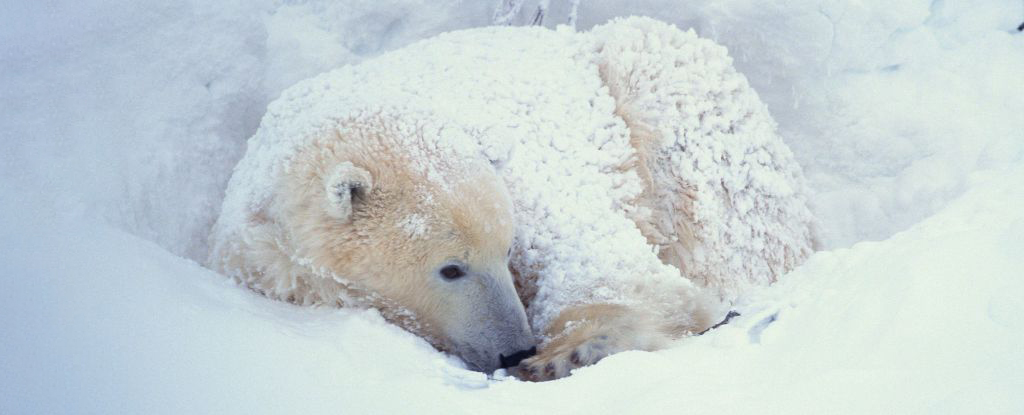Climate change is a threat to polar bear’s survival. Now they have a new deadly challenge facing them: bird flu. It was recently confirmed that a polar bear from northern Alaska has died from the disease.
The current strain of H5N1 influenza has affected a far wider range of species than any previously recorded strain. This has included several mammal species, such as foxes, otters, mink, sea lions and seals (including, for the first time, seals in Antarctica).
Cases have been detected in humans, too.
However, while some cases in mammals have been associated with large numbers of animal deaths, the few cases in humans have, so far, shown only mild symptoms or have been asymptomatic.
So, why are there such differences between species, and what are the implications of this polar bear’s death for the wider polar bear population, as well as other large mammals and humans?
Influenza viruses are highly adaptable.
Their relatively simple genetic code not only changes at random via mutation in the same way as truly living organisms, but also via reassortment.
This is where closely related viruses that infect the same host cell exchange genetic material to produce novel genomes. This can lead to greater adaptation for invasion, survival and replication within that host species.
This is probably how the current H5N1 strain has come to affect such a variety of bird species, with devastating effects for some populations.
Normally, large numbers of deaths associated with a disease are considered to be caused by the spread of a disease between individuals within the population. However, very specific genetic changes are needed for avian influenza viruses to become adapted to mammalian hosts.
These changes have not yet been detected in the current strain of H5N1. Although individual-to-individual transmission cannot be ruled out for some mammalian species that have been affected by H5N1, neither can vertical transmission – the transfer of the virus via consumption.
If we look at the list of mammals that have been infected by the current H5N1 strain, we see carnivores – and particularly those that are known to scavenge.
Very large numbers of some seabird species have died rapidly with H5N1. The likelihood of a seal or a polar bear finding and eating at least one infected bird carcass at an arctic colony suffering an outbreak seems quite high.
It is easy to imagine a pod of seals finding a colony of seabirds suffering an outbreak of H5N1 and gorging on carcasses. Under these circumstances, each seal would probably ingest and inhale massive viral loads.
Those massive viral loads may have overrun the seals’ immune systems, leading to rapid infection and death without infection being passed between seals.
Whether the polar bear encountered large numbers of dead seabirds, one or more seals that had become infected after eating dead seabirds or some other source of virus remains unknown.
The answer may be uncovered via testing of the virus and comparison with viruses found in species that occupy the same landscape. This approach is being used to track the spread of H5N1 between wild animals and poultry in the UK.
Thousands of #birds in Florida are dying from the H5N1 strain of the bird flu. And FWC veterinarians are concerned about the mass mortality events happening across the state. The lesser scaup ducks and vultures have the most deaths at this time. @SNNTV 📸:@MyFWC @SaveOurSeabirds pic.twitter.com/g94EKOKa5z
— Annette Gutierrez (@annette_tv) May 11, 2022
More to find out
Much of this remains hypothetical – for now. The consequences of the polar bear’s death for the species’ populations and for other large mammals cannot be predicted with a high degree of certainty.
But if genetic testing reveals that the polar bear’s H5N1 remains poorly adapted to mammalian hosts, we might expect few other cases in polar bears.
Any further cases might also be closely associated with outbreaks of H5N1 in a nearby seabird colony.
It also seems likely that the list of affected mammals and their geographical distribution should continue to grow, but relatively slowly. This list is likely to continue to include only carnivores – and scavengers in particular.
On the other hand, because influenza viruses are highly adaptable, ongoing surveillance of the H5N1 strain remains critically important. This will prepare us in case a new variant emerges that is adapted to mammalian hosts, potentially including humans.
The consequences of H5N1 for populations of some seabirds have been devastating. The consequences of failure to respond appropriately to a mammal-adapted H5N1 could be severe for polar bears – and for us.
Alastair Ward, Associate Professor of Biodiversity and Ecosystem Management, University of Leeds
This article is republished from The Conversation under a Creative Commons license. Read the original article.





